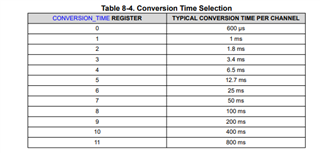Other Parts Discussed in Thread: OPT4048, OPT4003-Q1
Tool/software:
For an application involving color sensing of tiny particles moving fast in front of the sensor I see the OPT4060 has a conversion time from 600 μs, but the "Light Integration time per channel" says 25 ms, the lowest.
I would need fast sampling capacity like faster than 0.1 ms readings, and several channels like RGB IR (not filtered) and ever UV. On the other side I don't need a wide range o lighting level. I can set de amount of light needed. It's not an ambient light measuring device.
What kind o part do you suggest.
Best regards,
Santi


